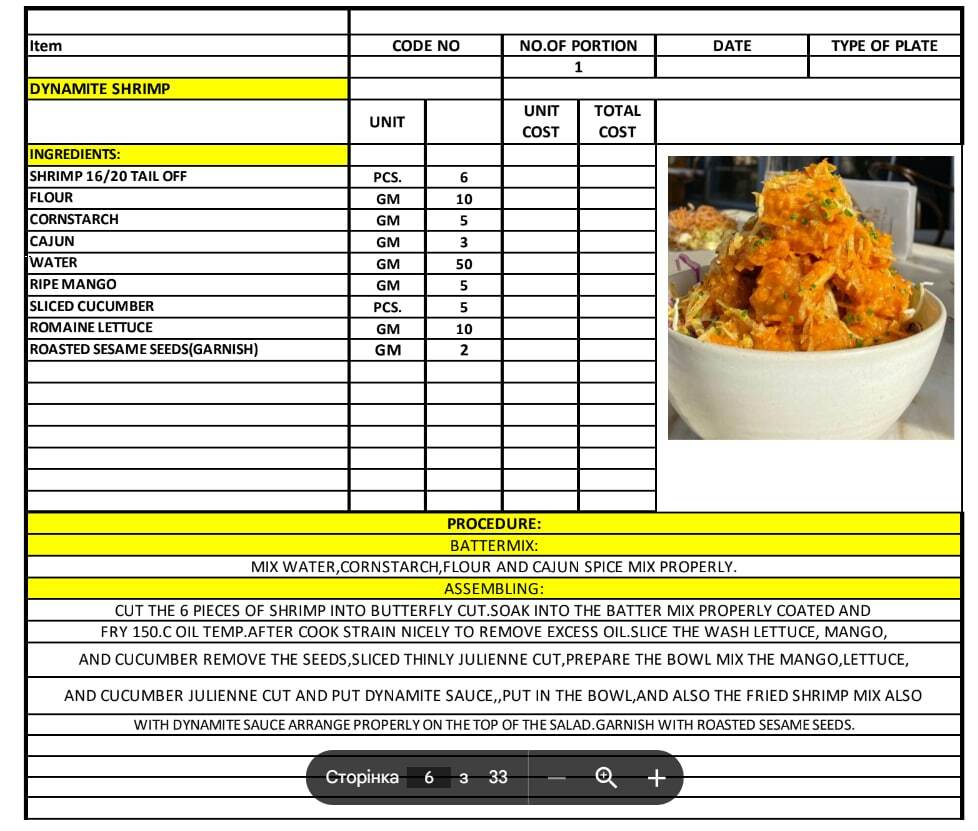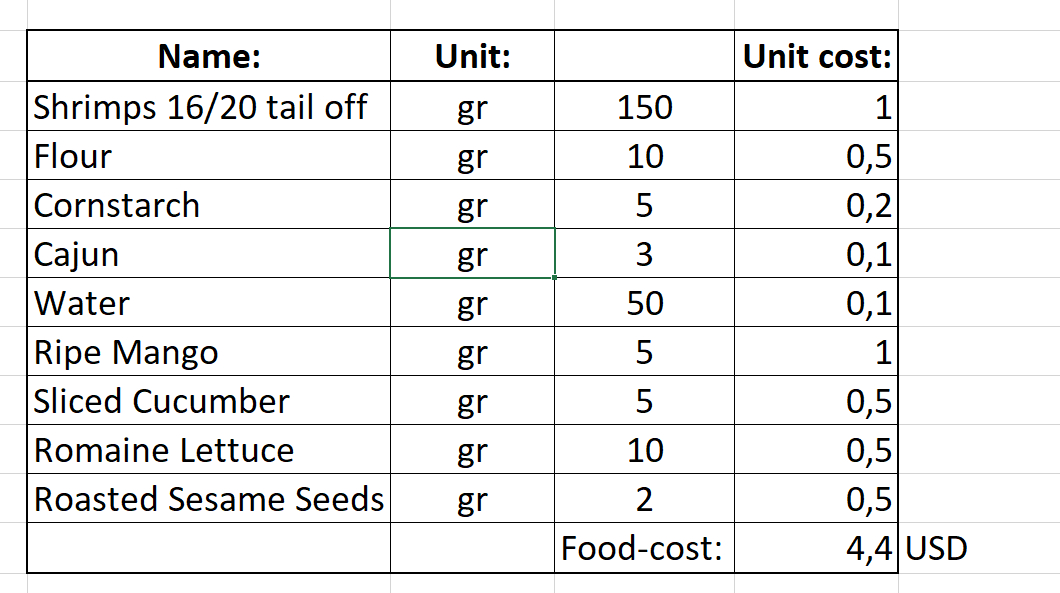This fundamental task not only ensures profitability but also enables chefs and restaurateurs to make informed decisions about menu pricing, sourcing ingredients, and maintaining quality standards. In this article, we'll delve into the art of calculating food cost, sharing essential tips and insights for restaurateurs and kitchen managers.
Understanding Food Cost
Food cost refers to the expense incurred by a restaurant when purchasing and preparing the ingredients used in its dishes. Calculating food cost is essential because it directly impacts a restaurant's profitability. To calculate food cost accurately, it is crucial to consider the following factors:
1. Ingredient Cost: This is the actual cost of the raw materials used in your recipes. It includes all the ingredients, from the main proteins and vegetables to seasonings and garnishes.
2. Waste and Yield: To calculate food cost accurately, account for any waste produced during food preparation and the yield you obtain from ingredients. This includes trimming, peeling, and discarding unusable portions.
3. Recipe Standardization: Standardizing recipes ensures consistency in portion sizes and ingredient usage. This is vital for accurate food cost calculations and maintaining the quality of dishes.
4. Inventory Management: Efficient inventory tracking helps in reducing food wastage, controlling costs, and preventing over-purchasing of ingredients.
Calculating Food Cost Percentage
Food cost percentage is a critical metric that determines how efficiently a restaurant manages its ingredient expenses. To calculate it, use the following formula:
Food Cost Percentage = (Total Ingredient Cost / Total Revenue) x 100
Here's a step-by-step guide to calculating food cost percentage:
1. Determine the time frame: Decide whether you want to calculate food cost on a daily, weekly, or monthly basis.
2. Gather data: Collect all the relevant data, including invoices for ingredient purchases and total revenue generated during the chosen time frame.
3. Calculate total ingredient cost: Add up the cost of all ingredients used in the kitchen during the specified period.
4. Determine total revenue: Calculate the total revenue generated during the same time frame.
5. Plug the values into the formula: Divide the total ingredient cost by the total revenue, and multiply the result by 100 to get the food cost percentage.
Interpreting Food Cost Percentage
Once you've calculated the food cost percentage, it's essential to interpret the results:
- Ideal Food Cost Percentage: The ideal food cost percentage varies depending on the type of restaurant and its pricing strategy. Generally, restaurants aim for a food cost percentage between 25% and 35%. Fine dining establishments may aim for a lower percentage, while quick-service restaurants might have a higher target due to lower menu prices.
- Monitoring and Adjusting: Regularly monitor your food cost percentage and make adjustments as needed. If the percentage is too high, you might need to reevaluate your menu pricing, portion sizes, or ingredient sourcing.
- Menu Engineering: Analyze your menu items individually to identify which dishes are the most and least profitable. This information can help you make informed decisions about menu changes or promotions.
Conclusion
Calculating food cost is a fundamental practice that every restaurant should adopt. It not only ensures financial sustainability but also helps maintain the quality and consistency of your dishes. By understanding the factors that contribute to food cost, implementing efficient inventory management, and regularly monitoring your food cost percentage, you'll be better equipped to navigate the complex world of restaurant management and thrive in a competitive industry.
Understanding Food Cost
Food cost refers to the expense incurred by a restaurant when purchasing and preparing the ingredients used in its dishes. Calculating food cost is essential because it directly impacts a restaurant's profitability. To calculate food cost accurately, it is crucial to consider the following factors:
1. Ingredient Cost: This is the actual cost of the raw materials used in your recipes. It includes all the ingredients, from the main proteins and vegetables to seasonings and garnishes.
2. Waste and Yield: To calculate food cost accurately, account for any waste produced during food preparation and the yield you obtain from ingredients. This includes trimming, peeling, and discarding unusable portions.
3. Recipe Standardization: Standardizing recipes ensures consistency in portion sizes and ingredient usage. This is vital for accurate food cost calculations and maintaining the quality of dishes.
4. Inventory Management: Efficient inventory tracking helps in reducing food wastage, controlling costs, and preventing over-purchasing of ingredients.
Calculating Food Cost Percentage
Food cost percentage is a critical metric that determines how efficiently a restaurant manages its ingredient expenses. To calculate it, use the following formula:
Food Cost Percentage = (Total Ingredient Cost / Total Revenue) x 100
Here's a step-by-step guide to calculating food cost percentage:
1. Determine the time frame: Decide whether you want to calculate food cost on a daily, weekly, or monthly basis.
2. Gather data: Collect all the relevant data, including invoices for ingredient purchases and total revenue generated during the chosen time frame.
3. Calculate total ingredient cost: Add up the cost of all ingredients used in the kitchen during the specified period.
4. Determine total revenue: Calculate the total revenue generated during the same time frame.
5. Plug the values into the formula: Divide the total ingredient cost by the total revenue, and multiply the result by 100 to get the food cost percentage.
Interpreting Food Cost Percentage
Once you've calculated the food cost percentage, it's essential to interpret the results:
- Ideal Food Cost Percentage: The ideal food cost percentage varies depending on the type of restaurant and its pricing strategy. Generally, restaurants aim for a food cost percentage between 25% and 35%. Fine dining establishments may aim for a lower percentage, while quick-service restaurants might have a higher target due to lower menu prices.
- Monitoring and Adjusting: Regularly monitor your food cost percentage and make adjustments as needed. If the percentage is too high, you might need to reevaluate your menu pricing, portion sizes, or ingredient sourcing.
- Menu Engineering: Analyze your menu items individually to identify which dishes are the most and least profitable. This information can help you make informed decisions about menu changes or promotions.
Conclusion
Calculating food cost is a fundamental practice that every restaurant should adopt. It not only ensures financial sustainability but also helps maintain the quality and consistency of your dishes. By understanding the factors that contribute to food cost, implementing efficient inventory management, and regularly monitoring your food cost percentage, you'll be better equipped to navigate the complex world of restaurant management and thrive in a competitive industry.
Example.
Your chef will prepare assembling card like this:
Your chef will prepare assembling card like this:

Using Excel or special software (which is in your restaurant, you will receive this calculation card:

So, the food cost of dynamite shrimps is about 4,4 USD. Next, according to your price policy you will create a sales price for this item.
Example of assembling cards (click to download)

